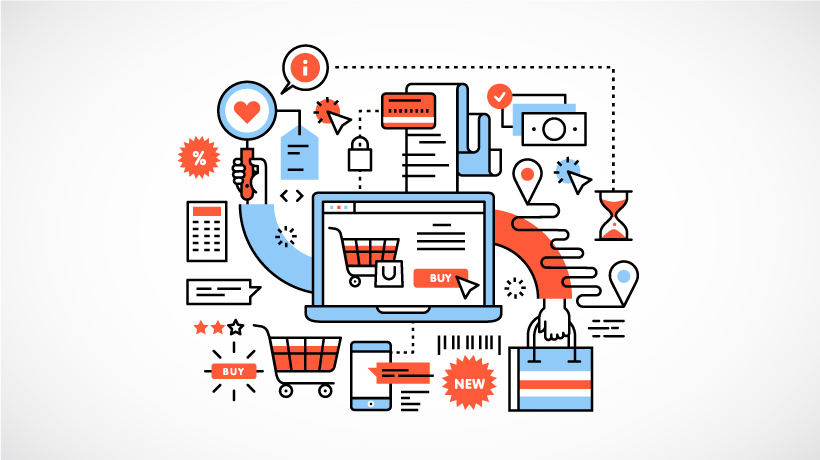Why And How To Do An LMS eCommerce Integration
The age of the internet is upon us thanks to some technologies such as smartphones, laptops, sensors, cloud, and wireless internet. As these technologies continue to become more affordable, the proliferation of seamless internet connectivity also continues to go up. According to Gartner, more than 20 billion connected things will be in use worldwide by 2020.
Today, we do almost everything online ranging from shopping to trading. In fact, in the recent years, several brick-and-mortar businesses have gone online. We can make big-ticket purchases, such as gold jewelry, and even buy a house online thanks to successful eCommerce ventures like Bluestone and Zillow, among others. Just like several other businesses, eLearning has also become popular replacing the traditional chalk-and-board learning model in most private and public domains.
While setting up a Learning Management System (LMS) is easy, keeping it afloat can be quite demanding. That's where LMS eCommerce integration comes in. Here we have listed various benefits of this integration and how you can effectively achieve it.
Benefits Of LMS eCommerce Integration You Can't Ignore
1. Improving User Experience And Sales
An eCommerce integrated LMS allows users to carry out all their transactions starting from registration to making the payment through a Single Sign-On (SSO). As they don't have to switch between multiple platforms, they get a seamless browsing experience which in turn helps boost your sales.
Purchasing eLearning products directly from the LMS is not only time saving, but also more secure than visiting a third-party payment portal. eCommerce integration also increases the marketability of your site. The eCommerce platform is meant to display and organize products. As a result, putting all the training programs and learning tools together in an aesthetically pleasing style becomes a lot easier.
You can also bundle live events, tickets, and discounts to the relevant courses. As an administrator, you can quickly set up new course pre-requisites, manage waitlists, and track attendance as well.
2. Advanced Analytics And Tracking
At the end of the day, your aim is to make money and increase your revenue over time. However, without supporting analytics, you won't be able to measure the success of your eLearning courses. You will also need to track the activity of registered users such as registration, attendance, downloads, chats, emails, payments, certificate generation, and learning hours. One of the inherent features of most eCommerce platforms is their analytics and tracking ability. In other words, eCommerce integration facilitates setting up an LMS with advanced analytics.
They can provide you with valuable insights into your eLearning programs. You can focus on most successful courses to increase your revenue and try to improve the least profitable ones. The in-depth analysis also helps you maintain accurate training records. Detailed reports provide accurate information about the user's progress. Both administrators and users can readily access these records any time they wish.
3. Flexible Pricing And Learning Hours
Any business, whether it is online or offline, needs a dynamic pricing model to keep attracting their customers. Owing to the competition, you may also need to change the prices more often than you think. In case of a conventional standalone LMS system, however, creating dynamic pricing requires substantial customization. Thus, hiring a professional to make the necessary customization isn't a financially viable option either.
Fortunately, you don't have to make such customizations in an eCommerce integrated LMS. You can readily offer different pricing models to different clients based on the number of students, location, and present market trends. You can also set up differential pricing models based on membership levels, payment options (bulk and installments), and purchasing patterns of individual users.
4. Real-Time Automated Management
An eCommerce integrated LMS will save considerable time and efforts spent on routine administrative chores. You can create general rules and attributes to streamline the registration, account creation, course progress, and certificate generation after successful completion of the course. All the user activities are saved automatically in real time without any human interference.
As there is no need to enter user details manually, the error margin is zero. If the users want to personalize a course, they can do so with ease and changes will be updated automatically. Automation provides you with additional time to focus on creating the perfect blend of high-quality content according to the client's requirement. Thus, you get more time to grow your business.
How To Integrate LMS And eCommerce
When it comes to LMS and eCommerce, you are better off hiring a professional to deal with the technical aspects. However, regardless of your technical background, you can choose which eCommerce platform best suits your LMS needs.
1. Choose The Right Platform
When it comes to LMS and eCommerce integration, the first thing that probably comes to your mind is which eCommerce platform to choose. As there are several eCommerce platforms available, however, choosing the right one can be a demanding task.
- Customization and Scalability
The eCommerce platform you choose must be easy to integrate and reflect your brand image as well. The integration should be seamless for both users as well as administrators. You may want to make several different aesthetic changes as your business develops. Therefore, the platform should provide substantial room for customization without compromising the quality and efficiency. Make sure the platform is also scalable and will be able to support the requirements of your growing business in the future.
- Cost
The cost will be a deciding factor in choosing the right platform. You have plenty of options, such as self-hosted (enterprise scale) platforms, third-party hosted platforms, add-ons, open source platforms, and basic platforms. You will need to make a one-time payment for self-hosted platforms. However, you are responsible for the maintenance and hosting costs. The third-party hosted platform vendors, on the other hand, will charge you monthly fee. Don't worry! There are several different types of platforms available at competitive prices.
2. Determine The Features You Need
Each eCommerce platform comes with distinct features. You just need to find out which features are most relevant to you and choose a platform accordingly. The first thing you need to think about is how the eCommerce platform will support your course format.
Will your course use just text and images or videos and audios (or podcasts), as well? Will you conduct live webinars or video conferences? You will also need to provide support to your users via email, live chat, discussion forums, and text messages. Make sure the platform comes with these features. Most importantly, however, the platform should be able to integrate with your existing add-ons such as payment processor, affiliate program manager, and email service provider among others.
You should be able to migrate those tools to the new platform or provide you with a better alternative. Lastly, the platform should be easy to handle. You don't want to spend hours wrangling with incomprehensible web technology, especially if you are not a techie.
3. Make Sure Both Brands Have Integrated Before
Integrating an LMS and eCommerce platform isn't a cakewalk. There are three parties involved in this process including you, your LMS vendor (if you have a third-party hosted LMS), and the eCommerce platform vendor. You can always ask both vendors to provide you with a detailed integration document.
If you have technical background in this field, only then you will be able to understand the entire process. So, this isn't the right option for those with no technical background whatsoever. Besides, the integration process is far more complicated in reality than it looks on the paper.
That's why it is always better to choose the eCommerce platform that has been merged with the type of your LMS successfully before. Find out if the eCommerce platform has been integrated with your specific LMS in the past. You can either ask the vendor directly or search the web to find out more information in this regard.
4. Test-Drive Shortlisted Platforms
You will be able to shortlist a few eCommerce platforms based on your requirements and budget. Instead of choosing the one you think is the best fit, you should test-drive at least top three shortlisted platforms. This may be time-consuming and a little expensive. However, in the end, it will be well worth it.
Make sure to use the same type of content, images, videos, and other course material for test-drives. Most eCommerce platforms may offer a free trial period. However, be prepared to pay the necessary fees up front just in case. You can run a mock course and register yourself as a student.
Remember, you will have to test the integration from both a user's point of view as well as an administrator's. So, set the testing parameters accordingly. Note down the response at every stage of the course. Rate your experience on a scale of 1 to 10 for each platform. It goes without saying that you should choose the one with the highest score.
Over To You
Just like any other product, you need to market your eLearning courses as well. Integrating your LMS with an eCommerce platform will not only boost your sales but also render your site with an exceptional User Interface. However, LMS eCommerce platform integration is easier said than done. Hopefully, this article will help clarify why you need this integration and how you can achieve it without breaking the bank. Are you using an eCommerce integrated LMS? Share your experiences in the comments below.







